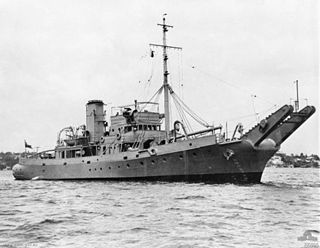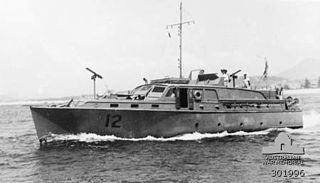Related Research Articles

HMAS Cootamundra (J316/M186), named for the town of Cootamundra, New South Wales, was one of 60 Bathurst-class corvettes constructed during World War II, and one of 36 initially manned and commissioned solely by the Royal Australian Navy (RAN).

HMAS Deloraine (J232/M232), named for the town of Deloraine, Tasmania, was one of 60 Bathurst-class corvettes constructed during World War II, and one of 36 initially manned and commissioned solely by the Royal Australian Navy (RAN). In January 1942 she evaded an attack by the Japanese submarine I-124 north-west of Darwin and was jointly credited with the submarine's sinking after inflicting the initial damage. She was present at the bombing of Darwin and survived unscathed.

HMAS Inverell, named for the town of Inverell, New South Wales, was one of 60 Bathurst-class corvettes constructed during World War II, and one of 36 initially manned and commissioned solely by the Royal Australian Navy (RAN).

HMAS Mildura (J207/M207), named for the city of Mildura, Victoria, was one of 60 Bathurst-class corvettes constructed during World War II, and one of 36 initially manned and commissioned by the Royal Australian Navy (RAN). The ship was laid down by Morts Dock & Engineering Co in 1940 and commissioned into the RAN in 1941.

HMAS Strahan (J363/M363), named for the town of Strahan, Tasmania, was one of 60 Bathurst-class corvettes constructed during World War II, and one of 36 initially manned and commissioned solely by the Royal Australian Navy (RAN).

HMAS Bunbury (J241/M241), named for the city of Bunbury, Western Australia, was one of 60 Bathurst-class corvettes constructed during World War II, and one of 36 initially manned and commissioned solely by the Royal Australian Navy (RAN).

HMAS Gladstone (J324/M324), named for the city of Gladstone, Queensland, was one of 60 Bathurst class corvettes constructed during World War II, and one of 36 that were initially manned and commissioned solely by the Royal Australian Navy (RAN). Built by Walkers Limited, the ship was commissioned in 1943.

The Sydney Harbour anti-submarine boom net was an anti-torpedo and submarine defence net that was in Sydney Harbour during World War II. It spanned the entire width of the harbour from Laing Point, Watsons Bay to Georges Head Battery, on the northern side of Sydney Harbour. The boom formed part of the Sydney Harbour defences which also included artillery batteries and patrol boats.

MV Macdhui was a steel-hulled passenger and cargo motor ship built by Barclay Curle & Company at the Clydeholm Yard, Whiteinch, Scotland for Burns, Philp & Company, Limited, Sydney NSW, Australia. She was launched on 23 December 1930 and completed during March 1931. She operated with the company's Burns, Philp Line with service to Papua and New Guinea. She was sunk in 1942, as a result of damage suffered by being hit by bombs from Japanese aircraft, near Port Moresby.

HMAS Karangi was a Kangaroo-class boom defence vessel operated by the Royal Australian Navy (RAN) during World War II. The third of three ships constructed by the Cockatoo Docks and Engineering Company at Cockatoo Island Dockyard based on the British Bar-class, Karangi was launched on 16 August 1941. After the war, the ship remained in active service with the RAN and played a small but key role in the British nuclear testing program. She was placed in reserve in 1953. In 1955, Karangi was reactivated and served for another two years until May 1957 and was eventually sold for scrap in 1966.

HMAS Southern Cross was an examination vessel, stores and troop carrier of the Royal Australian Navy (RAN) during the Second World War. Built in 1933 for the Melanesian Mission of the Anglican Church, she was requisitioned by the RAN on 29 March 1941 and commissioned on 18 June 1941.
HMAS Anaconda was an auxiliary vessel operated by the Royal Australian Navy (RAN) during the Second World War. The 125 ft (38 m) wooden hulled ship was constructed at Glenorchy, Tasmania as one of 32 motor vessels originally intended for the Department of Commerce, but later allocated to the Australian Army. Launched on 4 October 1944 as Australian Army AV 1369 Lagunta, she was subsequently transferred to the RAN and commissioned on 23 May 1945, assigned to the Services Reconnaissance Department under the command of Lieutenant Charles Haultain. The ship briefly served a workshop and headquarters function in support of clandestine operations in waters around Borneo and the Moluccas during the last days of the conflict.

HMAS Yarroma was formerly a luxury motor cruiser, commissioned as a channel patrol boat operated by the Royal Australian Navy (RAN) during the Second World War. She was one of thirteen similar vessels, known to Sydneysiders as the 'Hollywood Fleet'.
HMAS Toomaree was formerly a luxury motor cruiser, commissioned as a channel patrol boat and operated by the Royal Australian Navy (RAN) during World War II. She was one of thirteen similar vessels, known to Sydneysiders as the 'Hollywood Fleet'.
HMAS Seamist (10) was formerly a Sydney-based luxury motor cruiser, commissioned as a channel patrol boat into and operated by the Royal Australian Navy (RAN) during World War II. She was one of thirteen similar vessels, known to Sydney siders as the 'Hollywood Fleet'.
HMAS Silver Cloud (52) was a luxury motor cruiser, commissioned as a channel patrol boat operated by the Royal Australian Navy (RAN) during World War II. She was one of thirteen similar vessels, known to Sydneysiders as the 'Hollywood Fleet'.

HMAS Steady Hour (12) was formerly a luxury motor cruiser, commissioned as a channel patrol boat and operated by the Royal Australian Navy (RAN) during the Second World War. She was one of thirteen similar vessels, known to Sydney siders as the 'Hollywood Fleet'.

HMAS Nereus (19) was formerly a luxury motor cruiser, commissioned as a channel patrol boat operated by the Royal Australian Navy (RAN) during the Second World War. She was one of thirteen similar vessels, known to Sydneysiders as the 'Hollywood Fleet'.
Portmar was a United States-flagged merchant vessel that was constructed in response to World War I, operated by a succession of companies in the interwar period, then taken up for wartime shipping in World War II.
HMAS Lolita (14) was formerly a luxury motor cruiser, commissioned as a channel patrol boat into and operated by the Royal Australian Navy (RAN) during World War II. She was one of thirteen similar vessels, known to Sydney siders as the 'Hollywood Fleet'.
References
- ↑ The International Power Boat and Yachting Monthly, April 1936
- ↑ Referee (Sydney), 26 March 1936, p.12, See also National Archives Australia: MP138/1, 603/246/1769: Motor vessel Leilani
- ↑ National Archives Australia: MP138/1, 603/246/1769 - Motor vessel Leilani
- ↑ Navy, corporateName=Royal Australian. "HMAS Leilani". www.navy.gov.au. Retrieved 2021-09-28.
- ↑ National Archives Australia: AWM78, 481/1: Sydney Log
- ↑ National Archives Australia: AWM78, 381/1: Small Craft Base, Brisbane: Reports of Proceedings., December 1944
- ↑ National Archives Australia: AWM78, 387/1: Administration, New Guinea: Reports of Proceedings., Report of March 1945 dated 4 April 1945
- ↑ National Archives Australia: AWM78, 387/1: Administration, New Guinea: Reports of Proceedings., Report of May 1945 dated 4 June 1945
- ↑ "Australians at War Film Archive".
- ↑ Navy, corporateName=Royal Australian. "HMAS Leilani". www.navy.gov.au. Retrieved 2021-09-28.
https://www.navy.gov.au/hmas-leilani